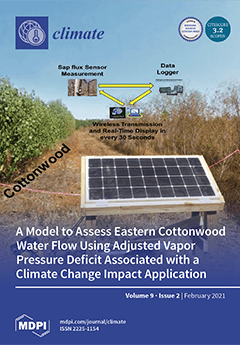Accurate monitoring and forecasting of drought are crucial. They play a vital role in the optimal functioning of irrigation systems, risk management, drought readiness, and alleviation. In this work, Artificial Intelligence (AI) models, comprising Multi-layer Perceptron Neural Network (MLPNN) and Co-Active Neuro-Fuzzy Inference
[...] Read more.
Accurate monitoring and forecasting of drought are crucial. They play a vital role in the optimal functioning of irrigation systems, risk management, drought readiness, and alleviation. In this work, Artificial Intelligence (AI) models, comprising Multi-layer Perceptron Neural Network (MLPNN) and Co-Active Neuro-Fuzzy Inference System (CANFIS), and regression, model including Multiple Linear Regression (MLR), were investigated for multi-scalar Standardized Precipitation Index (SPI) prediction in the Garhwal region of Uttarakhand State, India. The SPI was computed on six different scales, i.e., 1-, 3-, 6-, 9-, 12-, and 24-month, by deploying monthly rainfall information of available years. The significant lags as inputs for the MLPNN, CANFIS, and MLR models were obtained by utilizing Partial Autocorrelation Function (PACF) with a significant level equal to 5% for SPI-1, SPI-3, SPI-6, SPI-9, SPI-12, and SPI-24. The predicted multi-scalar SPI values utilizing the MLPNN, CANFIS, and MLR models were compared with calculated SPI of multi-time scales through different performance evaluation indicators and visual interpretation. The appraisals of results indicated that CANFIS performance was more reliable for drought prediction at Dehradun (3-, 6-, 9-, and 12-month scales), Chamoli and Tehri Garhwal (1-, 3-, 6-, 9-, and 12-month scales), Haridwar and Pauri Garhwal (1-, 3-, 6-, and 9-month scales), Rudraprayag (1-, 3-, and 6-month scales), and Uttarkashi (3-month scale) stations. The MLPNN model was best at Dehradun (1- and 24- month scales), Tehri Garhwal and Chamoli (24-month scale), Haridwar (12- and 24-month scales), Pauri Garhwal (12-month scale), Rudraprayag (9-, 12-, and 24-month), and Uttarkashi (1- and 6-month scales) stations, while the MLR model was found to be optimal at Pauri Garhwal (24-month scale) and Uttarkashi (9-, 12-, and 24-month scales) stations. Furthermore, the modeling approach can foster a straightforward and trustworthy expert intelligent mechanism for projecting multi-scalar SPI and decision making for remedial arrangements to tackle meteorological drought at the stations under study.
Full article





